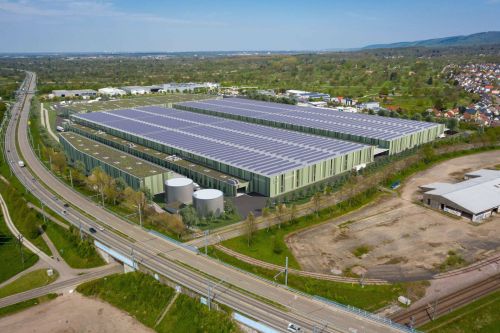In an ever more complex market
Retail & leisure
The opening of the first large shopping centre in Warsaw in ten years, the debut of modern concepts by retail chains and the increasingly visible trend of omnichannel sales: these were the events that dominated the Polish retail market in 2017 – and more challenges lie ahead. In 2018 we will see how shopping centres and their tenants adapt to the restrictions imposed on Sunday trading.
Slow and steady
Last year, the supply of retail space came to 380,000 sqm, according to figures from Knight Frank. The opening of Galeria Północna in Warsaw, developed by GTC, certainly was a significant event on the Polish shopping centre market in 2017. This is the first large building (64,000 sqm) to be put into operation in the capital in the last ten years. Another debut was the launch of the Wroclavia mall bringing with it the entry of its investor – Unibail-Rodamco – onto the Wrocław market. Another large facility that began operations in the past year was the Serenda shopping centre in Kraków. Its developer – Mayland Real Estate – has already announced that it will extend the project and connect it to the neighbouring Krokus mall. Slightly smaller retail centres that also opened over the year include Skende Shopping (24,000 sqm) developed by Ikea Centres together with a neigbouring Ikea store (33,500 sqm) in Lublin and Vivo! Krosno (22,000 sqm) developed by Immofinanz. “As a result around 380,000 sqm was completed in 2017 and the total modern retail stock in Poland increased to 11.6 mln sqm,” says Magdalena Czempińska, a market research director at Knight Frank. The supply of new space in the past year was almost the same as that delivered in 2016. Interestingly enough one first-generation shopping centre in Sosnowiec, which had closed in 2016, was converted into a warehouse centre a year later by Hillwood.
 Galeria Północna is the first large shopping centre to be opened in Warsaw in the last ten years
Galeria Północna is the first large shopping centre to be opened in Warsaw in the last ten years
As well as these new shopping centres, 2017 also saw the completion of a number of existing centre expansions, including Galaxy Szczecin by 17,000 sqm by its owner – Echo Polska Properties (EPP). EPP also completed a 3,800 sqm extension to its Outlet Park Szczecin. Meanwhile Outlet Graffica in Rzeszów (17,000 sqm) was created through the repositioning of the Galeria Graffica mall (owned by Star Europa). In 2017 expansions accounted for around 20 pct of the supply and the increasing share of extensions in the overall supply is a continuation of a trend that could be clearly seen on the market last year. “Since about half of the existing retail stock is more than ten years old, the owners of centres with no extension options often decide to modernise them in order to meet the requirements of current and future trends,” adds Magdalena Czempińska.
According to Knight Frank, in 2018 developers are set to deliver more space than they completed in 2017. Around 550,000 sqm of modern retail space was under construction in December 2017, of which 436,000 sqm was set to open in 2018 – including Forum in Gdańsk (62,000 sqm), Libero in Katowice (45,000 sqm) and Gemini Park in Tychy (36,000 sqm). The largest project currently under development is Galeria Młociny in Warsaw (73,500 sqm), which is scheduled to open in 2019. Almost 20 pct of total volume under construction comprises extensions of existing shopping centres.

 The newly opened Serenada inKraków is waiting
The newly opened Serenada inKraków is waitingto be extended and connected to the Krokus mall Wroclavia in Wrocław was opened in October 2017
Vacancy and rental rates
According to the Polish Retail Research Forum, 4 pct of retail stock was available for lease in Poland at the end of 2017. This means that over the previous twelve months the vacancy rate has increased by 0.5 ppt. “This is the result of the fact that several retail schemes still offered space emptied by Praktiker in 2017, while some other locations struggled with units left by Alma Delicatessen. Additionally, not all of the new schemes had been 100 pct pre-leased before the opening date,” claims Magdalena Czempińska. Of the largest cities in Poland, the market with the lowest vacancy rate was Szczecin (2.8 pct) followed by Warsaw and Wrocław (2.9 pct each). Among medium-sized markets, Toruń (1.7 pct), Kielce (1.8 pct) and Bydgoszcz (1.9 pct) led the way with the lowest vacancy rates. Stable demand for retail space means that rental rates have also not undergone any fundamental changes. “At the end of 2017, the highest headline rents for the best quality retail space in shopping centres (units of below 100 sq m) were reached in Warsaw and amounted to even EUR 100 per sqm per month. Monthly rents for the high quality space in other major cities varied between EUR 35 and EUR 70 per sqm, and in mid-sized markets ranged between EUR 25 and EUR 60. In the smallest markets rents were between EUR 20–40 per sqm,” says Magdalena Czempińska.
Easy come, easy go
The real estate consultancies differ over the number of new brands that debuted on the Polish retail market in 2017. According to JLL, 20 new brands opened stores – three more than in 2016, but Cresa claims that 30 new brands debuted over the period. These new tenants according to Knight Frank included Freya (Stary Browar in Poznań), Hamleys (Galeria Północna in Warsaw) as well as Nissa and Victoria’s Secret (Arkadia in Warsaw), to name but a few. Melon Fashion Group, which owns the Befree, Zarina and Love Republic brands, started its operations in Poland by opening two Befree stores (in Stary Browar in Poznań and CH Riviera in Gdynia) as well as Love Republic and Zarina stores in Galeria Północna in Warsaw. Meanwhile ,Ukrainian clothing chain Goldi opened in the Wroclavia shopping centre, as did Spanish interior accessories chain La Mallorquina. However a number of brands including Praktiker, Marks & Spencer, Dorothy Perkins, Stenders, Springfield and Polish deli-supermarket chain Alma went out of business.
Virtual becomes real
According to Knight Frank, with the rapid development of e-commerce brands that operate from bricks and mortar stores are increasingly moving online, such as shoe store CCC. But the reverse trend can also be seen with online operators moving into the real world. In 2017, a number of stores that had only been operating online (such as perfumy.pl and eobuwie.pl) or on temporary premises (such as Militaria.pl and Telakces.com) opened brick-and-mortar stores. Through this trend, customers can become accustomed to new forms of sales and significantly change their expectations and shopping habits due to the innovative formats introduced by such tenants. “The development of e-commerce has also meant that shopping centres have ceased to be mainly shopping destinations and are starting to aspire to be places where you can spend your free time. As a result, making a good impression on visitors will be one of the most important elements of operating many retail facilities. We could already see these types of activities back in 2017 and in future years they may become even more prevalent. Examples include arranging public spaces with, for instance, the addition of relaxation areas, expanding the gastronomy and entertainment zones in many centres as well as holding and supporting cultural, artistic and social events – such as the Higher Level Project in Galeria Katowicka. Such activities undertaken by shopping centre owners can be strengthened by the campaigns of individual brands. To improve the shopping experience, brands can create personalised products, such as NIKEiD, or introduce new store arrangements,” explains Magdalena Czempińska.
Tenants and shopping centre owners are now mainly focusing on adapting their space to meet the expectations of their clients. Developers are following the trend for there to be more and more space for entertainment and food courts, which are being modernised more frequently (e.g. Grand Kitchen in Warsaw's Arkadia, Tygiel Smaków in Silesia City Center in Katowice and a new restaurant section in Galeria Wisła in Płock). Meanwhile, retail chains are developing new formats and concepts, such as the Empik Future Store and new concepts by Esotiq, Go Sport, CCC and Reserved’s ‘open to public’ format. “2018 will be the first year of the Sunday trading ban, coming into force on March 1st 2018. Because gastronomy and entertainment were excluded from the act, you can expect shopping centre owners to try to increase the share of these services in their tenant-mix,” claims Knight Frank’s market research director.
Some retail chains are considering opening their stores as showrooms on those Sundays that will be covered by the trade ban. The employee would be a consultant rather than a salesman while purchases would be possible online because internet sales are not covered by the act. Could this really happen? We can only wait and see.
More shopping for Romania
In 2017, modern retail stock increased to 3.48 mln sqm in shopping centres and retail parks, according to the latest figures by CBRE. The national average retail density now stands at 160 sqm per 1,000 inhabitants, while in Bucharest it is 540 sqm per 1,000 inhabitants. Over 100,000 sqm of new retail space was delivered over the year and currently app. 150,000 sqm is under construction in cities such as Brașov, Bistrița, Târgu Mureș, Satu Mare, Craiova and Timișoara. The total volume of extensions completed over the year came to 43,000 sqm, while by 2019 this figure is expected to reach 95,000 sqm, out of which Bucharest will account for more than 70 pct of the total. Bucharest prime shopping centre yields came down to 6.75 pct, while yields for the main regional cities a lso decreased to 7.75 pct compared to Q4 2017.





















































